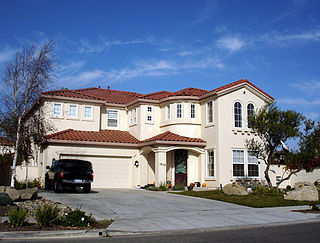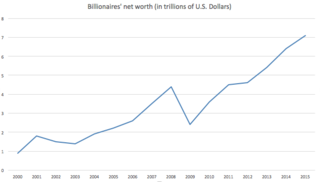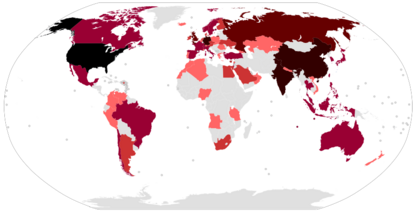
An offshore bank is a bank that is operated and regulated under international banking license, which usually prohibits the bank from establishing any business activities in the jurisdiction of establishment. Due to less regulation and transparency, accounts with offshore banks were often used to hide undeclared income. Since the 1980s, jurisdictions that provide financial services to nonresidents on a big scale can be referred to as offshore financial centres. OFCs often also levy little or no corporation tax and/or personal income and high direct taxes such as duty, making the cost of living high.

A millionaire is an individual whose net worth or wealth is equal to or exceeds one million units of currency. Depending on the currency, a certain level of prestige is associated with being a millionaire. Many national currencies have, or have had at various times, a low unit value, in many cases due to past inflation. It is much easier and less significant to be a millionaire in those currencies, thus a millionaire in Hong Kong or Taiwan, for example, may be merely averagely wealthy, or perhaps less wealthy than average. A millionaire in Zimbabwe in 2007 could have been extremely poor. Because of this, the term 'millionaire' generally refers to those whose assets total at least one million units of a high-value currency, such as the United States dollar, euro, or pound sterling.
Net worth is the value of all the non-financial and financial assets owned by an individual or institution minus the value of all its outstanding liabilities. Financial assets minus outstanding liabilities equal net financial assets, so net worth can be expressed as the sum of non-financial assets and net financial assets. This concept can apply to companies, individuals, governments, or economic sectors such as the financial corporations sector, or even entire countries.

A billionaire is a person with a net worth of at least one billion units of a given currency, usually of a major currency such as the United States dollar, euro, or pound sterling. It is a sub-category of the concept of the ultra high-net-worth individual. The American business magazine Forbes produces a global list of known U.S. dollar billionaires every year and updates an internet version of this list in real time. The American oil magnate John D. Rockefeller became the world's first confirmed U.S. dollar billionaire in 1916.

The distribution of wealth is a comparison of the wealth of various members or groups in a society. It shows one aspect of economic inequality or economic heterogeneity.
A wealth tax is a tax on an entity's holdings of assets or an entity's net worth. This includes the total value of personal assets, including cash, bank deposits, real estate, assets in insurance and pension plans, ownership of unincorporated businesses, financial securities, and personal trusts. Typically, wealth taxation often involves the exclusion of an individual's liabilities, such as mortgages and other debts, from their total assets. Accordingly, this type of taxation is frequently denoted as a netwealth tax.

GIC Private Limited is a Singaporean sovereign wealth fund that manages the country's foreign reserves. Established by the Government of Singapore in 1981 as the Government of Singapore Investment Corporation, of which "GIC" is derived from as an acronym, its mission is to preserve and enhance the international purchasing power of the reserves, with the aim to achieve good long-term returns above global inflation over the investment time horizon of 20 years.

Wealth management (WM) or wealth management advisory (WMA) is an investment advisory service that provides financial management and wealth advisory services to a wide array of clients ranging from affluent to high-net-worth (HNW) and ultra-high-net-worth (UHNW) individuals and families. It is a discipline which incorporates structuring and planning wealth to assist in growing, preserving, and protecting wealth, whilst passing it onto the family in a tax-efficient manner and in accordance with their wishes. Wealth management brings together tax planning, wealth protection, estate planning, succession planning, and family governance.

Private banking is a general description for banking, investment and other financial services provided by banks and financial institutions primarily serving high-net-worth individuals (HNWIs) – those with very high income and/or substantial assets. Private banking is presented by those who provide such services as an exclusive subset of wealth management services, provided to particularly affluent clients. The term "private" refers to customer service rendered on a more personal basis than in mass-market retail banking, usually provided via dedicated bank advisers. It has typically consisted of banking services, discretionary asset management, brokerage, limited tax advisory services and some basic concierge services, typically offered through a gateway provided by a single designated relationship manager.

Northern Trust Corporation is an American financial services company headquartered in Chicago, Illinois that caters to corporations, institutional investors, and ultra high net worth individuals. Northern Trust is one of the largest banking institutions in the United States and one of the oldest banks in continuous operation. As of June 30, 2022, it had $1.7 trillion in assets under management and $17 trillion in assets under custody. Northern Trust Corporation is incorporated in Delaware.

An alternative investment, also known as an alternative asset or alternative investment fund (AIF), is an investment in any asset class excluding capital stocks, bonds, and cash. The term is a relatively loose one and includes tangible assets such as precious metals, collectibles and some financial assets such as real estate, commodities, private equity, distressed securities, hedge funds, exchange funds, carbon credits, venture capital, film production, financial derivatives, cryptocurrencies, non-fungible tokens, and Tax Receivable Agreements. Investments in real estate, forestry and shipping are also often termed "alternative" despite the ancient use of such real assets to enhance and preserve wealth. Alternative investments are to be contrasted with traditional investments.

The inequality of wealth has substantially increased in the United States in recent decades. Wealth commonly includes the values of any homes, automobiles, personal valuables, businesses, savings, and investments, as well as any associated debts.
Global assets under management consists of assets held by asset management firms, pension funds, sovereign wealth funds, hedge funds, and private equity funds.
Spear's, founded in 2006 by William Cash, is a bimonthly British magazine for high-net-worth individuals and those in the financial service industries. It has been called "the Bible of the banking fraternity" by GQ and "a European rival to Forbes" by The Evening Standard. Nick Cohen called it "The best portrait I have seen of a world beyond our means and comprehension", in The Spectator. Its subscribers include over 30,000 of Europe's decision-makers and wealthy. William Cash, editor-at-large of Spear's, has twice won Editor of the Year at the PPA Awards. Spear's is now published by Progressive Digital Media. The launch in 2006 included publicity from The Independent, The Guardian, the Luxist and The Times.

BTG Pactual is a Brazilian financial company that operates in the markets of investment banking, wealth management, asset management, corporate lending and sales and trading. It offers advisory services in mergers and acquisitions, wealth planning, loans and financings, as well as investment solutions and market analyses. It is the sixth largest banking institution in Brazil, the eleventh largest in Latin America, and the largest investment bank in Latin America and the Caribbean.

UBS Group AG is a multinational investment bank and financial services company founded and based in Switzerland. Headquartered in Zürich, it maintains a presence in all major financial centres as the largest Swiss banking institution and the largest private bank in the world. UBS client services are known for their strict bank–client confidentiality and culture of banking secrecy. Because of the bank's large positions in the Americas, EMEA, and Asia Pacific markets, the Financial Stability Board considers it a global systemically important bank.
Plutonomy is the science of production and distribution of wealth.

The World's Billionaires is an annual ranking of people who are billionaires, i.e., they are considered to have a net worth of US$1 billion or more, by the American business magazine Forbes. The list was first published in March 1987. The total net worth of each individual on the list is estimated and is cited in United States dollars, based on their documented assets and accounting for debt and other factors. Royalty and dictators whose wealth comes from their positions are excluded from these lists. This ranking is an index of the wealthiest documented individuals, excluding any ranking of those with wealth that is not able to be completely ascertained.











